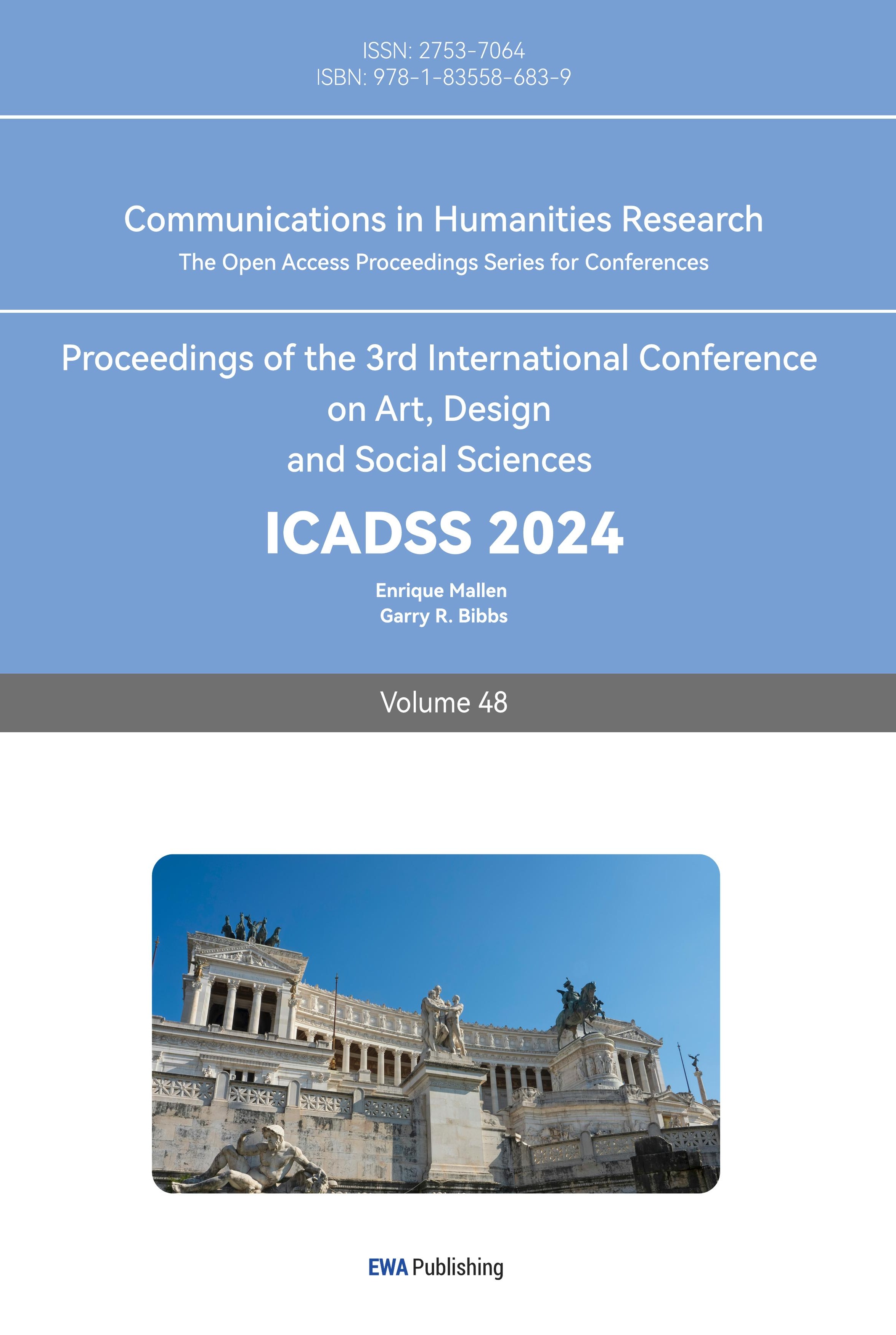1. Introduction
Are you apprehensive of death? In fact, there have been three shifts in Western history in attitudes towards death. The first occurred in the 12th century when the recognized sources of knowledge transitioned from religious thought to secular scientific reasoning, leading to a shift in societal consciousness from the concern for others' deaths to a focus on individual death. The second shift occurred in the 17th century when the deaths of others once again overshadowed the perception of one's own death, during which time death also took on romanticized portrayals. The third shift occurred in the 19th century due to advancements in science and medical intervention, causing the public to regard death as a dreadful and taboo occurrence [1]. While not everyone may have personally experienced death, I surmise that you are somewhat apprehensive or concerned about it. As someone who has never experienced death, the sudden tragic news of my friend's death in a car accident was simply unbelievable. She was so young, and her passing made me realize that death is not just a concern for the elderly, prompting me to contemplate this rarely noticed topic in daily life. Perhaps some lean towards avoiding the topic of death, or maybe it's due to the fast pace of modern society, where attention quickly shifts amidst rapid information turnovers. However, it seems that this event only prompted momentary shock and reflection in everyone, as she is rarely mentioned afterward. This paper focuses on three significant time periods: the Middle Ages, the 17th century, and the 19th century. It explores the societal and religious-cultural reasons for the changing expressions of death, as well as their specific manifestations in architecture. Additionally, it presents the prospects and challenges for funerary architecture in the future.
2. The influence of power and religion on the manifestation of death
Michel Foucault, in his work "Discipline and Punish," mentions that prior to the 17th century, punishment of crimes involved the public display of cruel treatment towards the bodies of the offenders [2]. During this period, the characteristics of European feudal society were evident, with clear hierarchical structures, where the bodies of the offenders were controlled by the monarchy and openly punished, serving as a display of power. However, particularly in the late Middle Ages (1424-1425), the outbreak of famine and plague claimed thousands of lives, and the dance of death was one of the highly representative products of that time. Paintings and poetry surrounding this theme bluntly depicted the chaos created by the grim reaper, disregarding the societal hierarchy of the time, and presenting a terrifying scene of equality in the face of death, regardless of one's social status or rank [3]. This phenomenon challenged the authority of the church at the time, and while it did not directly overthrow the existing social order, it to some extent reflected the abstraction of power given to life and death—no longer in the hands of a specific king, but rather in the hands of an uncontrollable disease. This form of power is devoid of subjective intent, and one does not perceive the disease as specifically targeting them for death.
By the end of the 18th century, the Enlightenment emphasized human nature and rights, leading to increasing questioning and opposition to the public use of cruel punishment methods. In the early 19th century, with the advent of modern prisons, punishment changed from torture of the body to discipline of the soul [2]. In addition, the locus of punishment has become decentralized, no longer under the singular dominion of royal authority. This rationalizes punishment, making death no longer the sole domain of the condemned, with legal principles standing as the measure, and the form of social power becoming depersonalized. It is not until modern legal regulations become more refined that the rights in modern society become transparently invisible, with the treatment of death row inmates in accordance with legal standards, no longer under the control of a specific entity. Hence, in modernity, power is an abstract systemic phenomenon, where life and death are not bestowed upon us by kings or gods, but by non-subjective entities like disease, accidents, and the judiciary, which are not tangible or visible. Throughout the entire historical process, the manifestation of rights has transitioned from concretization to abstraction, leading to the abstraction of the way death is presented in modernity, rendering death itself invisible.
Ari discussed the primary factors of social change as the changes in structure [4], and how the social structure can influence the change in social culture and religious beliefs, thus leading to changes in the forms of artistic and cultural manifestations. The body is an important dimension in religious studies, as the religious significance is bestowed by material biology [5]. Furthermore, the body was at the core of secular religion in the 18th century [6]. This acknowledges the materiality and significance of the body, thus under the influence of religious culture, people become obsessed with displaying their bodies. At the same time, religion also emphasizes the importance of the soul, as the author's study on Brazilian culture indicates that people connect with the soul for medical purposes and to console relatives of the deceased [5]. Although the article suggests that this phenomenon signifies a close connection and interdependence between the body and the soul, I believe it reflects the idea that the soul can exist separately from the body, as if our entire being is abstract consciousness and the body is merely a vessel. To a certain extent, it can be said that even when a person passes away, it is only the demise of the physical body, while the soul can still exist.
Therefore, many burial sites designed under the influence of religion or by architects with religious beliefs themselves often include a place to house the coffin, as the act of commemorating the body remains important, albeit taking on a more abstract or hidden form. For instance, architect Carlo Scarpa designed the Brion Family Cemetery in San Vito d'Altivole, Italy. Scarpa envisioned it to be a public space or garden, hence creating such an extravagant burial site for a wealthy family [7]. The cemetery eschews the gloomy and terrifying image of death and lacks a visible body, appearing rather abstract in its design approach. The designer did not focus extensively on the deceased's body, but instead placed the coffin discreetly and subtly beneath an arch (as shown in Figure 1, the grave of the married couple). The Brion family cemetery is considered a public garden adjacent to the city of the dead, as opposed to traditional burial grounds emphasizing gravel pits. The architectural elements of the Brion family cemetery present themselves as independent pavilions within the garden [8-9]. Furthermore, Scarpa integrated the concept of life into the burial site, viewing death as the origin of life. The cemetery supports life and serves as a vessel for the memories of the departed [9]. Scarpa ingeniously incorporated the shape of a double circle, symbolizing infinity in mathematics, and in some regions, a double circle-shaped ring is worn for weddings. Scarpa stated that this symbolizes the theme of life [9].
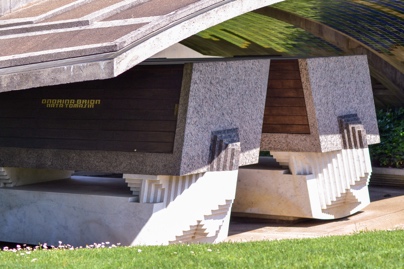
Figure 1: The grave of the married couple. [8]
3. Facing cultural challenges
Perhaps you may have a query, as religious beliefs fade, how can those who are not religious understand or accept the concept of the soul? In "The Vicar of Wakefield," a miraculous cowboy allows a woman to see her deceased son one last time, thus restoring her faith in God [10]. This does not necessarily mean embracing a new deity, as that would entail far too much. I would venture to say that this feat seems achievable in the present, as abstract virtual technology appears capable of serving as the miraculous cowboy. Through advanced techniques, it may be possible to animate the image of the deceased on a screen, even allowing one to hear their voice.
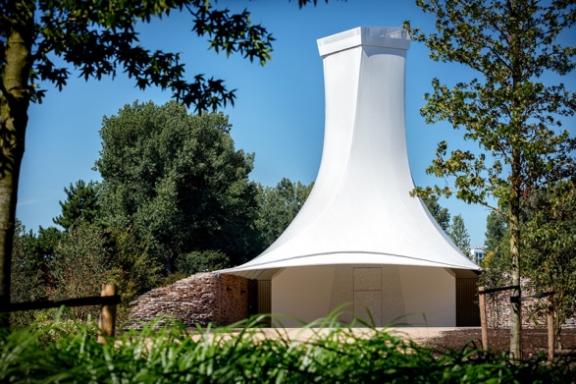
Figure 2: Zorgvlied Crematorium. [11]
However, I do not advocate this approach, as such a display is too literal. I believe that almost everyone seeing the screen would recognize that the person on the screen has passed away and would not necessarily accept the notion of his soul still existing in the world just because of a very realistic virtual image. Therefore, I hope to interpret it through architecture using a larger dimension framework, allowing people to understand the body and soul after death through their own imagination and feelings. As architecture is a form of artistic expression, the so-called one thousand readers will have one thousand Hamlets, and everyone's perception of architecture is different. For example, the Zorgvlied Crematorium (as shown in Figure 2, Zorgvlied Crematorium) in Amsterdam uses stone to represent the body and white fabric to represent the soul. The entire building forms a tall, inverted funnel shape, with an opening at the top facing the sky. The designer's concept is that the body is the heavy stone in the earth, and the soul is the light one ascending into the sky along the white fabric [12].
Moreover, another example the crematorium hall of the Baumshulenweg in Germany features a facade embedded with louver-controlled glass, keeping the deceased's body out of sight, already melding into the heavens under the bathing sunlight [13]. The interior of the hall is adorned with towering concrete pillars, extending from the ground to the ceiling, where they converge with holy light, seemingly infinitely high, reaching all the way to God, as if witnessing the sublime ascension of the soul. Although ancient stones were regarded as symbols of eternity, at this moment, it is the shining pinnacle of the pillars that upholds the eternity of the soul.
Perhaps you still do not believe in the existence of the soul, or perhaps you cannot embrace this design concept. However, architecture can connect or convey different ways of thinking, that is, how you feel in the architecture. You may consider stone and white fabric as mere materials, representing nothing, and that is also permissible, because it is a concept you can accept. Architecture conveys its meaning in the virtual world; what you see from one side and the other side is different, and you only need to accept the side you understand. Even if in the end you still do not believe in the existence of the soul, you have already embraced this architecture. Alternatively, if we replace the words, the soul is virtual, as are virtual things such as feelings and thoughts. If you enter this building and feel that even though your body is on the ground, looking at the 16-meter-high white fabric and the sunlight pouring in from the skylight makes you feel light. Although the word "soul" is not directly mentioned, you have already noticed that your feelings have separated from your body, which means that you have understood.
4. Seeking the manifestation of future death
Although the abstraction of death has been realized, the influence of religion or traditional culture has led to the body still not being entirely invisible in the cemetery. Will there ever be a day when the body can be completely concealed?
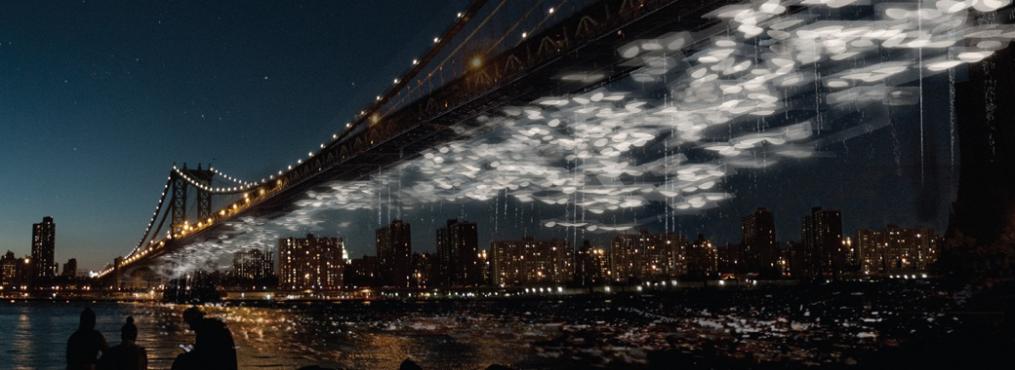
Figure 3: Constellation Park, at the Manhattan Bridge (rendering). [14]
The American Death Laboratory has proposed a grand vision - the Constellation Park (as shown in Figure 3, constellation Park at the Manhattan Bridge). Here, the deceased will shimmer on a bridge in the Manhattan skyline. It hangs on the bridge, without occupying ground space, and integrates into the city's existing infrastructure. This proposal is not only committed to finding an environmentally friendly and space-saving way of handling remains, but also aims to serve as a commemorative design to provide spiritual solace [15]. It is evident that the representation of death can become immaterial, transitioning from a physical structure to a symbolic installation. This mode of commemoration becomes completely abstracted and integrates into the city in a decorative and meaningful form. However, it is undeniable that death remains a sensitive topic, and the transition for most people from underground burials to skyward memorials will be a process, inevitably giving rise to cultural disputes.
In reviewing the past with Africa as an example, it is evident that traditional burial practices involved interment of the deceased in the land. This was upheld as a means of preserving the memory of the departed among the living, by creating a site for future generations to visit and reflect. Therefore, the subsequent introduction of cremation, which challenged this cultural tradition, was met with disdain by the populace. However, facing issues such as limited burial space, environmental pollution, and the cost of traditional burials, the country is now advocating for cremation, despite its limited acceptance among the public [16]. This illustrates the necessity for people to consider new approaches to adapt to evolving trends, driven by societal issues. Undoubtedly, proposals rooted in historical development may carry more weight than mere conjecture. Hence, it is imperative to contemplate future forms of memorialization within the context of understanding the national and cultural history.
Taking a deeper look, is the increasing abstraction of death in architecture a good thing? When we consider other art forms such as painting, literature, and film, it seems that there is a constant emergence of death-related themes. Particularly in film, the portrayal often tends toward realism, with scenes of fallen soldiers in war films and eerie and absurd depictions of the grim reaper in horror movies. Is this a commendable portrayal? In the Pakistani film "Joyland," there is a scene where the body is carefully washed before burial, perhaps as a way of bidding farewell to the deceased with intimate contact rather than fear [17]. Similarly, at the Vietnam Veterans Memorial (as shown in Figure 4, the names on the Vietnam Veterans Memorial). This is a monument inscribed with the names of all the martyrs, people no longer touch the bodies directly but instead touch the names engraved on the stone. This demonstrates how architecture can establish a physical connection between the living and the dead, an eternal connection. This approach integrates death into everyday life, as the names on the wall no longer evoke horror but rather normalize death, allowing society to collectively accept it. Is this level of abstraction the most suitable? Perhaps abstracting death still requires experimentation and exploration, as finding the optimal way to integrate it into daily life is essential.
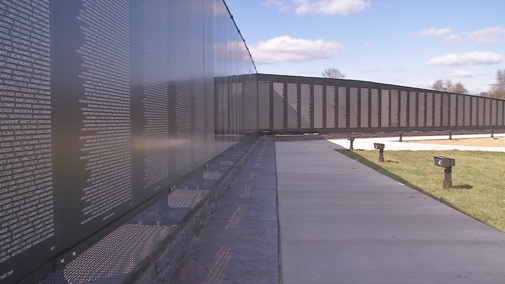
Figure 4: The names on the Vietnam Veterans Memorial. [18]
5. Conclusion
The paper first expounds the changes in social structure and religious beliefs behind the abstraction of death in modernity. This is due to the shift in social power structure from specific rulers to judicial systems or non-subjective entities such as diseases, leading to the abstraction of death. Furthermore, from a religious perspective, the focus of death shifts from the body to the soul, putting forth the viewpoint that the soul exists independently of the body and attempting to guide people to understand and accept this concept. Throughout the entire text, linked by architecture as a medium, it portrays the forms of death in architecture from the past, present, and future, especially envisioning the development of future urban death architecture. It raises the question of whether it is advisable to completely abstract death and whether the abstraction of its representation is a good thing. The study of death aims to help people change their fear and anxiety towards death and seeks to find a rational way to represent death in modernity. This is done to commemorate the deceased and comfort the living. Furthermore, the hope is to prompt people to consider how to address social issues related to death through this text, to fill the gap in people's ability to cope with death, and to make the topic of death no longer a taboo, but rather a subject worthy of deep consideration.
References
[1]. San Filippo, David Ph.D., "Historical Perspectives on Attitudes concerning Death and Dying" (2006). Faculty Publications. 29. https://digitalcommons.nl.edu/faculty_publications/29
[2]. Foucault, Michel. Discipline and Punish: The Birth of the Prison. Penguin Books, 1975.
[3]. Taşdelen, Pınar. “Passages in the Garden: An Iconology of the Brion Tomb.” Halkbilimi Araştırmaları Derneği, vol. 6, no. 1, 2023, pp. 120–23.
[4]. Arı, Yılmaz. “Social Change and Religion.” Dorlion Journal, vol. 2, no. 1, June 2024, pp. 76–95, https://doi.org/10.5281/zenodo.11491788. Complementary Index.
[5]. Stefan. “Spirits and Bodies as an Interdependent Network of Relations and Approach to the Study of Religion in Brazil.” International Journal of Latin American Religions, vol. 8, Springer Science+Business Media, Mar. 2024, pp. 194–208, https://doi.org/10.1007/s41603-024-00230-3. Accessed 20 Aug. 2024.
[6]. Harvey, Karen, and Emily Vine. “Prayer for Family and Friends: The Body and Religion in Eighteenth-Century Britain.” Historical Journal, vol. 67, no. 3, Cambridge University Press, Mar. 2024, pp. 1–24, https://doi.org/10.1017/s0018246x24000086. Accessed 7 May 2024.
[7]. Stern, Michael A. “Passages in the Garden: An Iconology Ot the Brion Tomb.” Landscape Journal, vol. 13, no. 1, 1994, pp. 39–57, https://doi.org/10.3368/lj.13.1.39.
[8]. "In the art gallery, I am searching for the stories behind the architecture: Carlo Scarpa's Brion Family Cemetery." - 8.” ArchDaily, 2020, www.archdaily.cn/cn/991931/xun-zhao-jian-zhu-bei-hou-de-gu-shi-qia-luo-star-si-qia-pa-carlo-scarpa-de-bu-li-ang-jia-zu-mu-yuan/633dc5da4dba6e4ea66c2e23-architecture-that-hides-stories-a-look-at-the-brion-tomb-by-carlo-scarpa-photo?next_project=no. Accessed 6 Aug. 2024.
[9]. Li, Nan. “On Analysis of Landscape Design for Brion Family’s Tomb.” SHANXI ARCHITECTURE, vol. 36, no. 6, pp. 5–6, https://doi.org/10.3969/j.issn.1009-6825.2010.06.003. Chinese.
[10]. Dobson, Eleanor. “The Ghost of Oscar Wilde: Fictional Representations.” Ghosts - or the (Nearly) Invisible : Spectral Phenomena in Literature and the Media, by Maria Fleischhack, Frankfurt Am Main Pl Academic Research, 2016, pp. 35–44.
[11]. “Gallery of Zorgvlied Crematorion / GROUP a - 6.” ArchDaily, 2020, www.archdaily.com/795987/zorgvlied-crematorion-group-a/57e74deae58ece9e1d00025b-zorgvlied-crematorion-group-a-photo. Accessed 4 Aug. 2024.
[12]. “Zorgvlied Crematorion / GROUP A.” ArchDaily, 27 Sept. 2016, www.archdaily.com/795987/zorgvlied-crematorion-group-a. Accessed 5 Aug. 2024.
[13]. Situ Y. “Ritual of Death: Design and Construction of Crematorium Baumschulenweg in Berlin.” Time + Architecture, vol. 3, 1 Jan. 2004, pp. 118–123. Accessed 1 Aug. 2024.
[14]. “Making Light of Death.” Columbia Magazine, magazine.columbia.edu/article/making-light-death. Accessed 26 Aug. 2024
[15]. “Making Light of Death.” Columbia Magazine, magazine.columbia.edu/article/making-light-death. Accessed 10 Apr. 2024.
[16]. C. Masona, and R.D. Gwisai. “African Journal on Land Policy and Geospatial Sciences.” Revues.imist.ma, vol. 6, no. 3, May 2023, revues.imist.ma/index.php/AJLP-GS/index.
[17]. Joyland. Directed by Sadik Sam, 2022.
[18]. Worldnow.com, 2024, wdrb.images.worldnow.com/images/16581394_G.jpg?lastEditedDate=1524178955000. Accessed 17 Sept. 2024.
Cite this article
Xi,X. (2024). The Transformation of Incorporating Death into Architecture --- From the Specific to the Abstract. Communications in Humanities Research,48,106-111.
Data availability
The datasets used and/or analyzed during the current study will be available from the authors upon reasonable request.
Disclaimer/Publisher's Note
The statements, opinions and data contained in all publications are solely those of the individual author(s) and contributor(s) and not of EWA Publishing and/or the editor(s). EWA Publishing and/or the editor(s) disclaim responsibility for any injury to people or property resulting from any ideas, methods, instructions or products referred to in the content.
About volume
Volume title: Proceedings of the 3rd International Conference on Art, Design and Social Sciences
© 2024 by the author(s). Licensee EWA Publishing, Oxford, UK. This article is an open access article distributed under the terms and
conditions of the Creative Commons Attribution (CC BY) license. Authors who
publish this series agree to the following terms:
1. Authors retain copyright and grant the series right of first publication with the work simultaneously licensed under a Creative Commons
Attribution License that allows others to share the work with an acknowledgment of the work's authorship and initial publication in this
series.
2. Authors are able to enter into separate, additional contractual arrangements for the non-exclusive distribution of the series's published
version of the work (e.g., post it to an institutional repository or publish it in a book), with an acknowledgment of its initial
publication in this series.
3. Authors are permitted and encouraged to post their work online (e.g., in institutional repositories or on their website) prior to and
during the submission process, as it can lead to productive exchanges, as well as earlier and greater citation of published work (See
Open access policy for details).
References
[1]. San Filippo, David Ph.D., "Historical Perspectives on Attitudes concerning Death and Dying" (2006). Faculty Publications. 29. https://digitalcommons.nl.edu/faculty_publications/29
[2]. Foucault, Michel. Discipline and Punish: The Birth of the Prison. Penguin Books, 1975.
[3]. Taşdelen, Pınar. “Passages in the Garden: An Iconology of the Brion Tomb.” Halkbilimi Araştırmaları Derneği, vol. 6, no. 1, 2023, pp. 120–23.
[4]. Arı, Yılmaz. “Social Change and Religion.” Dorlion Journal, vol. 2, no. 1, June 2024, pp. 76–95, https://doi.org/10.5281/zenodo.11491788. Complementary Index.
[5]. Stefan. “Spirits and Bodies as an Interdependent Network of Relations and Approach to the Study of Religion in Brazil.” International Journal of Latin American Religions, vol. 8, Springer Science+Business Media, Mar. 2024, pp. 194–208, https://doi.org/10.1007/s41603-024-00230-3. Accessed 20 Aug. 2024.
[6]. Harvey, Karen, and Emily Vine. “Prayer for Family and Friends: The Body and Religion in Eighteenth-Century Britain.” Historical Journal, vol. 67, no. 3, Cambridge University Press, Mar. 2024, pp. 1–24, https://doi.org/10.1017/s0018246x24000086. Accessed 7 May 2024.
[7]. Stern, Michael A. “Passages in the Garden: An Iconology Ot the Brion Tomb.” Landscape Journal, vol. 13, no. 1, 1994, pp. 39–57, https://doi.org/10.3368/lj.13.1.39.
[8]. "In the art gallery, I am searching for the stories behind the architecture: Carlo Scarpa's Brion Family Cemetery." - 8.” ArchDaily, 2020, www.archdaily.cn/cn/991931/xun-zhao-jian-zhu-bei-hou-de-gu-shi-qia-luo-star-si-qia-pa-carlo-scarpa-de-bu-li-ang-jia-zu-mu-yuan/633dc5da4dba6e4ea66c2e23-architecture-that-hides-stories-a-look-at-the-brion-tomb-by-carlo-scarpa-photo?next_project=no. Accessed 6 Aug. 2024.
[9]. Li, Nan. “On Analysis of Landscape Design for Brion Family’s Tomb.” SHANXI ARCHITECTURE, vol. 36, no. 6, pp. 5–6, https://doi.org/10.3969/j.issn.1009-6825.2010.06.003. Chinese.
[10]. Dobson, Eleanor. “The Ghost of Oscar Wilde: Fictional Representations.” Ghosts - or the (Nearly) Invisible : Spectral Phenomena in Literature and the Media, by Maria Fleischhack, Frankfurt Am Main Pl Academic Research, 2016, pp. 35–44.
[11]. “Gallery of Zorgvlied Crematorion / GROUP a - 6.” ArchDaily, 2020, www.archdaily.com/795987/zorgvlied-crematorion-group-a/57e74deae58ece9e1d00025b-zorgvlied-crematorion-group-a-photo. Accessed 4 Aug. 2024.
[12]. “Zorgvlied Crematorion / GROUP A.” ArchDaily, 27 Sept. 2016, www.archdaily.com/795987/zorgvlied-crematorion-group-a. Accessed 5 Aug. 2024.
[13]. Situ Y. “Ritual of Death: Design and Construction of Crematorium Baumschulenweg in Berlin.” Time + Architecture, vol. 3, 1 Jan. 2004, pp. 118–123. Accessed 1 Aug. 2024.
[14]. “Making Light of Death.” Columbia Magazine, magazine.columbia.edu/article/making-light-death. Accessed 26 Aug. 2024
[15]. “Making Light of Death.” Columbia Magazine, magazine.columbia.edu/article/making-light-death. Accessed 10 Apr. 2024.
[16]. C. Masona, and R.D. Gwisai. “African Journal on Land Policy and Geospatial Sciences.” Revues.imist.ma, vol. 6, no. 3, May 2023, revues.imist.ma/index.php/AJLP-GS/index.
[17]. Joyland. Directed by Sadik Sam, 2022.
[18]. Worldnow.com, 2024, wdrb.images.worldnow.com/images/16581394_G.jpg?lastEditedDate=1524178955000. Accessed 17 Sept. 2024.





